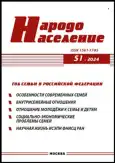Based on data from a comprehensive observation of the living conditions of the population, representative of all regions of the Russian Federation (more than 100 thousand people were surveyed), an analysis is given of the characteristics of communications between family members within the family itself and with external contractors on the issues of support and care. The older the parents, the more they need help from their children: 86.9% elderly people aged 70 years or more need care during illness 82.1% need help with housework, 78.5% with buying food and things, 72.9%.need monetary assistance One third of parents (27.8%) receive financial assistance from their children. More than half (57.2%) of parents aged 60–65 years and the majority of those aged 80 years and older (77.7%) report that their children take care for them during illness. One type of support is provided for 12.3% of parents, two types of help — for 16.4%, three — 17.9%, four — 12.8%, five — 14.1% (26. 5% do not receive any help). Parents also help their children under the age of 18 who live separately, for example, pensioners aged 70 years and older help in raising their grandchildren (51.2%), give them money (34.3%), food (14.1%), buy things (8.6%). With age, family ties are less and less often reinforced by meetings and “close-range” communication. At pre-retirement age (55–59 years) 18.4% people do not meet with friends, relatives or colleagues at least once a week, at the age of 60–64–19.8%, 65–69 years — 24.2%, 70–74 years — 27.6%, 75–79 years — 31.1%, and the situation is even worse for people aged 80 years and older — 37.8%. Parents and children support each other financially and physically; at the same time, it is important to pass on the traditions and values of preserving family ties and transmitting family values from the older generation to the younger.
 4-4
4-4


 5-16
5-16


 17-27
17-27


 28-37
28-37


 38-52
38-52


 53-65
53-65


 66-80
66-80


 81-93
81-93


 94-106
94-106


 107-119
107-119


 120-131
120-131


 132-146
132-146


 147-160
147-160


 161-176
161-176


 177-189
177-189


 190-201
190-201


 202-208
202-208










